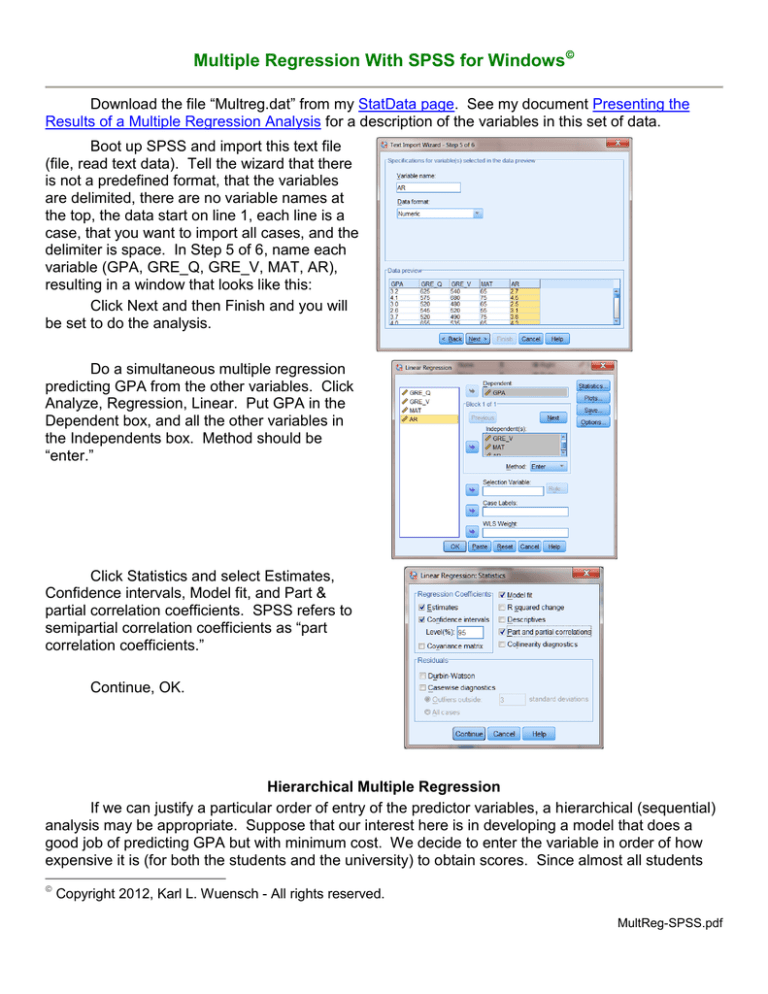
Multiple Regression With SPSS for Windows
Download the file “Multreg.dat” from my StatData page. See my document Presenting the
Results of a Multiple Regression Analysis for a description of the variables in this set of data.
Boot up SPSS and import this text file
(file, read text data). Tell the wizard that there
is not a predefined format, that the variables
are delimited, there are no variable names at
the top, the data start on line 1, each line is a
case, that you want to import all cases, and the
delimiter is space. In Step 5 of 6, name each
variable (GPA, GRE_Q, GRE_V, MAT, AR),
resulting in a window that looks like this:
Click Next and then Finish and you will
be set to do the analysis.
Do a simultaneous multiple regression
predicting GPA from the other variables. Click
Analyze, Regression, Linear. Put GPA in the
Dependent box, and all the other variables in
the Independents box. Method should be
“enter.”
Click Statistics and select Estimates,
Confidence intervals, Model fit, and Part &
partial correlation coefficients. SPSS refers to
semipartial correlation coefficients as “part
correlation coefficients.”
Continue, OK.
Hierarchical Multiple Regression
If we can justify a particular order of entry of the predictor variables, a hierarchical (sequential)
analysis may be appropriate. Suppose that our interest here is in developing a model that does a
good job of predicting GPA but with minimum cost. We decide to enter the variable in order of how
expensive it is (for both the students and the university) to obtain scores. Since almost all students
Copyright 2012, Karl L. Wuensch - All rights reserved.
MultReg-SPSS.pdf
2
who are applying to graduate programs are required to take the GRE, our applicants should already
have taken the GRE, and it is inexpensive to have the scores sent to us. Accordingly, we shall enter
the GRE variables first. Not many schools require the MAT, so this may represent an additional
expense for our typical student. We shall enter MAT in the second step. Bringing students to
campus for an interview is rather expensive, so we shall enter that variable last.
Analyze, Regression, Linear, Reset. Scoot GPA into the Dependent box and GRE_Q and
GRE_V into the Independents box.
Click Statistics. Select Estimates, Confidence Intervals, Model fit, R squared change, and Part
and partial correlations. Continue.
Click Next. The Independents box will clear. Scoot MAT into the Independents box and click
Next again. Finally, scoot AR into the independents box and click Next a third time. OK.
Please note that you will obtain three multiple regressions, and each will have a different error
term.
Model Summary
Change Statistics
Model
R
R Square
Adjusted R
Std. Error of the
R Square
Square
Estimate
Change
F Change
df1
df2
Sig. F Change
1
.697a
.485
.447
.4460
.485
12.726
2
27
.000
2
b
.617
.573
.3920
.132
8.949
1
26
.006
c
.640
.583
.3874
.023
1.629
1
25
.214
3
.786
.800
a. Predictors: (Constant), GRE_V, GRE_Q
3
b. Predictors: (Constant), GRE_V, GRE_Q, MAT
c. Predictors: (Constant), GRE_V, GRE_Q, MAT, AR
Suppose we wish to put a confidence interval on the change in R2 due to adding MAT to the
model that already had the two GRE variables. SPSS gives F(1, 26) = 8.949. When you enter this
into Smithson’s CI program you get
The value r2=.2561 is the squared
partial change in R2 (pr2)due to adding
MAT in the second step, and the CI [.0478,
.4457] is also for the partial change. Have
a look at the partial statistics provided by
SPSS. The partial r for MAT is .506.
Square that and you get .256.
Model
Zeroorder
1
2
The pr tells us what proportion of
the residual variance in the previous model
was explained by adding MAT to that first
model. I prefer the squared semipartial
correlation coefficient (sr2), which tells us
what proportion of all of the variance in the
predicted variable is explained uniquely by
MAT.
Correlations
2
3
Partial
Part
GRE_Q
.611
.472
.384
GRE_V
GRE_Q
GRE_V
MAT
GRE_Q
.581
.611
.581
.604
.611
.422
.494
.286
.506
.400
.334
.352
.185
.363
.262
GRE_V
.581
.279
.174
MAT
.604
.401
.262
AR
.621
.247
.153
a. Dependent Variable: gpa
To convert pr2 to sr2 do this: srB2 prB2 (1 RY2.A ) where A is the previous set of variables (the
two SAT variables), B is the new set of variables (MAT), and Y is the outcome variable. For our data,
2
srMAT
.256(1 .485) .132. Notice that this value (.132) is the semipartial change in R2, the simple
difference between the R2 after adding MAT and the R2 before adding MAT. Take the square root of
.132 and you get .363, the semipartial r (which SPSS calls the Part Correlation).
To get the confidence interval for the semipartial change in R2, simply multiply the endpoints of
CI for the partial change in R2 by (1 - .485), yielding a 90% CI of [.025, .230].
4
Of course, the number of variables in the second set can be greater than one. Suppose we
add both MAT and AR in the second step.
Model Summary
Change Statistics
Model
1
2
R
R Square
Adjusted R
Std. Error of the
R Square
Square
Estimate
Change
F Change
df1
df2
Sig. F Change
a
.485
.447
.4460
.485
12.726
2
27
.000
b
.640
.583
.3874
.155
5.397
2
25
.011
.697
.800
a. Predictors: (Constant), GRE_V, GRE_Q
b. Predictors: (Constant), GRE_V, GRE_Q, MAT, AR
For the set (MAT & AR) the pr2 is .3016 and the sr2 is (1-.485)(.3016) = .155, the amount by
which R2 increased when MAT and AR were entered in one step. The 90% CI for the increase in R2
is [.024, 236].
Why did I obtain 90% rather than 95% confidence intervals? It is because I wanted the
confidence intervals to be consistent with the results of a test of the null that the partial effect is zero
using an alpha of .05. See Confidence Intervals for R and R2 .
See Also:
Multiple Regression with SAS
Lessons on Multiple Regression
Karl L. Wuensch, Dept. of Psychology, East Carolina University, Greenville, NC.
September, 2012.



